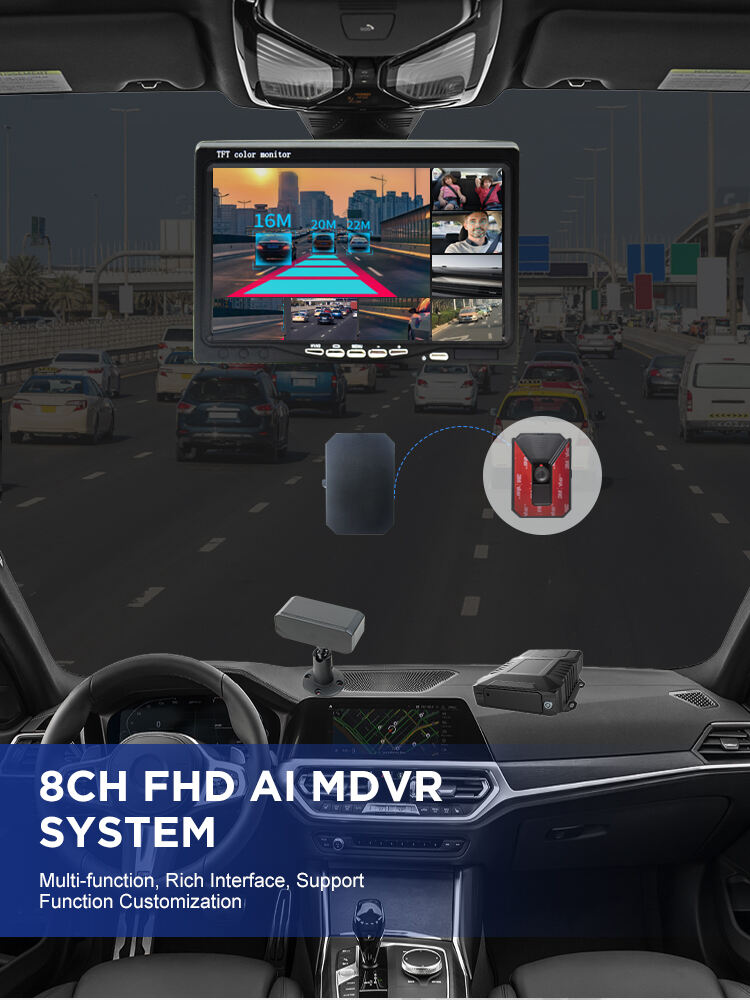Smarter fleet oversight with integrated monitoring
Fleet management today goes far beyond simply tracking vehicles. Businesses that operate large fleets face challenges in insurance costs, compliance, driver safety, and theft prevention. By adopting MDVR systems with AI capabilities, managers gain access to advanced features that directly address these pain points. From video capture to cloud-based analytics, MDVR provides clear oversight that allows companies to cut unnecessary losses and strengthen compliance. For fleet operators, it is no longer about whether to invest in MDVR but how to maximize its full potential in daily operations.
Insurance savings through AI-enabled MDVR
Preventing accidents with driver monitoring
Insurance companies base their pricing on risk, and unsafe driving behavior is one of the largest risk factors. MDVR systems equipped with DMS cameras allow managers to monitor drivers for fatigue, distraction, or mobile phone use. When unsafe actions are detected, alerts are generated so managers can intervene. This direct visibility helps reduce accident rates and makes a strong case for lower insurance premiums. Fleets with MDVR in place demonstrate accountability and safer practices, which insurance providers recognize in pricing models.
Supporting claims with video evidence
When accidents do happen, proving what really occurred is often difficult. MDVR systems record high-quality video and location data that can be reviewed through the cloud platform. Video evidence is critical for showing whether a driver was at fault or if external circumstances caused the incident. By resolving disputes quickly, MDVR reduces legal costs and ensures insurers have confidence in claim accuracy. This reliability further contributes to lowering insurance expenses over time.

Enhancing compliance through MDVR systems
Cloud-based oversight and reporting
Regulatory compliance often requires detailed reporting and record-keeping. With MDVR, managers can access video, GPS location, alerts, and historical data from a central cloud platform. This consolidated view simplifies compliance checks and reduces the risk of missed reporting. Instead of relying on manual logs, managers can present accurate data that reflects real fleet performance. The transparency of MDVR makes compliance audits smoother and less costly.
Enforcing driver accountability
MDVR is not only a tool for tracking vehicles but also a system for monitoring behavior. Managers can identify risky actions such as harsh braking, speeding, or fatigue-related errors. Through the MDVR platform, managers can issue feedback, enforce corrective training, or even assign penalties. This improves compliance with company rules and transportation regulations. Over time, accountability transforms driver culture into one that values safety and responsibility.
AI-powered features of MDVR
Advanced recognition functions
Modern MDVR systems integrate AI capabilities such as ADAS, BSD, license plate recognition, and facial recognition. ADAS and BSD help detect vehicles in blind spots or issue lane departure warnings, reducing collision risks. License plate recognition supports access control or cargo monitoring, while facial recognition strengthens driver identification. Each of these functions expands the utility of MDVR, making it a multi-purpose tool for improving safety and security.
Data-driven decision-making
Beyond monitoring, the value of MDVR lies in its ability to generate actionable insights. Through cloud connectivity, managers can analyze patterns across the fleet, including frequency of alerts, routes taken, and driver compliance levels. MDVR data becomes a foundation for strategic decisions, such as adjusting schedules, optimizing routes, or redesigning training programs. With this intelligence, managers transform fleet oversight into measurable improvements.
Practical management benefits of MDVR
Optimizing fleet operations
Managers are often tasked with balancing efficiency and safety. MDVR simplifies this task by providing real-time access to vehicle and driver data. Managers can monitor trip progress, ensure vehicles follow designated routes, and detect issues immediately. This constant visibility prevents costly delays or mismanagement. In addition, the ability to remotely supervise multiple vehicles reduces the need for excessive on-site supervision, cutting administrative overhead.
Improving driver behavior through oversight
One of the most powerful benefits of MDVR is its impact on driver conduct. With constant monitoring, drivers are more aware of their behavior, reducing tendencies toward speeding or reckless driving. Managers can use MDVR footage to educate and guide drivers, reinforcing best practices and discouraging risky actions. When necessary, evidence from MDVR can also support disciplinary action, ensuring that standards are enforced consistently.
Integration of MDVR into insurance and safety strategies
Reducing fraudulent claims
Fraudulent claims are a hidden cost that many fleets face. MDVR deters fraudulent activity by capturing video that confirms or disproves allegations. Insurance providers value this transparency, and companies using MDVR are less likely to be targeted by opportunistic fraudsters. Preventing even a small number of fraudulent claims can save significant amounts in payouts and legal fees.
Strengthening trust with insurance partners
Insurance companies want to work with clients who demonstrate control and responsibility. By showing they use MDVR, fleet operators position themselves as reliable partners. Insurers gain confidence knowing that every event can be verified with video and data. This trust translates into favorable negotiations for insurance terms, which lowers overall costs while maintaining comprehensive coverage.
FAQs
How does MDVR help reduce insurance costs
MDVR provides video evidence, driver monitoring, and AI-enabled safety features that lower accident risks and resolve claims faster. These capabilities reduce financial exposure and help fleets negotiate better insurance premiums.
What compliance advantages does MDVR provide
Through cloud-based data access, managers can review trip records, alerts, and video at any time. This ensures fleets remain compliant with safety and reporting requirements, while reducing the burden of manual documentation.
What AI features are available in MDVR systems
AI-powered MDVR includes ADAS, BSD, driver monitoring through DMS, license plate recognition, and facial recognition. These features enhance safety, reduce collisions, and support management efficiency.
Why should managers prioritize MDVR in fleet oversight
MDVR equips managers with the tools to monitor drivers, enforce accountability, and improve operational efficiency. It reduces risks, lowers costs, and strengthens both compliance and safety across the fleet.


